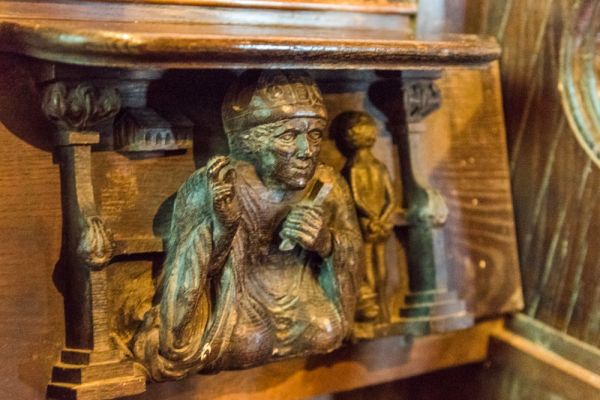It's not like they don't tell you. Wed 11 May 2022

Artisanal steganography beneath the priest's chair at Screveton Church, Nottinghamshire. Source 1

And this one before the cross was snapped off. Source
You can see why so-called 'iconoclasts' destroyed around 10,000 of England's market and church crosses. This 1906 carving may have been an attempt to get past the Anglican church's attempts to sanitise 'religion'. A steganographic reference to "hand over your first born" - also known as "blood sacrifice".
Post-Reformation churches rarely contain 'figurative' wall paintings - meaning paintings that show 'idols'. The reasons for the ban aren't really about religion. They about suppressing folk memory.

A rare wall painting in Great Sturton's All Saints church hints at what tithes had really been about. Source
It's been badly damaged by a century of rain - presumably when All Saint's was "carefully reduced in size", so only 'interpretations' exist. From Society for Lincolnshire Heritage & Archaeology's copy of a nearby inscription:
Archdeacon Bonney in 1848... described it as "Time and Death".
Time on the left, is winged and scantily clad and is running over a tombstone, forelock flying, hour-glass in one hand, scythe in the other.
To me, the structure on the left looks more like a font than a tombstone. And what's with the red-coloured scythe?
Maybe that's why the inscription neglects to say that Time was previously known as 'Chronos' - a Titan god who ate his children.

Scythe in hand, Chronos prepares a child. Source: PaintingValley
Perhaps that explains the red splotch.
Rubens' unambiguous painting of Chronos at lunch is better known:

Rubens' depiction of Chronos got to the meat of the problem. Source: PaintingValley
Now we can re-interpret the figure on the right of All Saint's church wall-painting. An inscription in All Saint's says it is:
Death, represented by a skeleton walking away on another tombstone on the right, holds a spade in one hand, and possibly a mattock in the other.
Given the painting is dated to just after the Reformation, it possibly depicts the well-evidenced English practice of grinding the bones of the dead then spreading them on to fields as a soil amendment called marl.
© All rights reserved. The original author retains ownership and rights.
-
Perhaps it was created by Dr Allen's ecclesiastical wood-carving enterprise ↩
More of this investigation:
IHASFEMR
More by tag:
#human meat, #human bone, #Manimal Farm